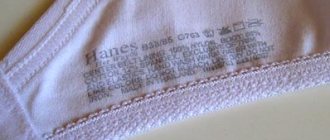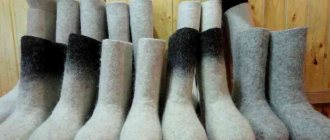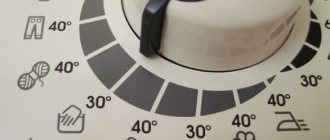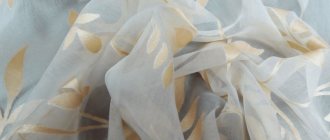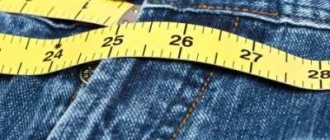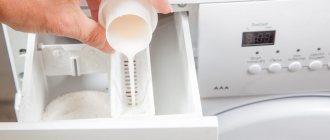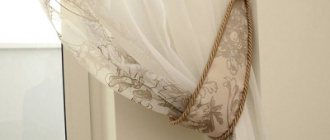Washing curtains is necessary to keep your home clean. During operation, dirt appears on the surface of the product, dust and soot particles accumulate. Kitchen curtains quickly absorb a variety of odors. In order not to spoil the appearance of beautiful curtains, you need to wash them correctly, selecting special cleaning products.
Is it necessary to wash curtains?
Experts say that you have to clean the fabric material on windows at least twice a year, because dust and soot particles regularly settle on them. It is recommended to take into account a number of factors that influence the condition of the curtains, so that after washing the product does not lose its former aesthetic appearance.
Conditions affecting the degree of contamination of curtains:
- Place of residence. If the apartment is located in the central part of the city and the windows overlook a busy street where a huge amount of traffic constantly passes, then the curtains will get dirty much faster. Therefore, you will have to wash the curtains quite often in the washing machine or with your own hands.
- What floor is the apartment on? At the top, exhaust gases and dust particles for curtains are not so dangerous, since they will not be able to fly into an open window in large quantities. Residents of the first floors will have to clean and do laundry much more often.
- Season of the year. In spring and summer, windows in houses are constantly open, so curtains will absorb much more dust and dirt.
Dry cleaning services
Dry cleaning includes curtains that are difficult to wash on your own.
These can be products from:
- natural silk;
- wool;
- blackout curtains;
- velvet curtains.
All of them are expensive, so their care should be left to professionals.
You can find a dry cleaner through advertisements on the Internet or in the newspaper. Often this service is provided by cleaning companies that clean apartments and houses.
You can deliver the curtains to the company yourself, or call a courier to your home. In this case, you will need to pay additionally for delivery. Specialists will not only rid the curtains of dirt and dust, but also iron them . Some organizations offer their clients to hang them on a curtain rod.
The cost of work depends on the level of complexity. You can wash one medium-weight item in a washing machine for 300 rubles. The price of professional manual cleaning starts from 520 rubles.
How to properly wash curtains made from different fabrics
In order for the product to retain its original appearance after washing, you need to know and adhere to the basic rules for cleaning curtains made from various types of fabrics. So, it is better not to machine wash blackout curtains with an acrylic layer. Products with conventional three-layer thread weave can withstand increased load.
The decorative metallic coating of high-tech curtains may become damaged and lose its integrity during machine washing. If the label indicates that you should not wash it yourself at home, then you need to dry clean it.
Curtains on both sides are regularly vacuumed. After the procedure, you need to open the window to ventilate the room. If there are stains on the fabric, they are cleaned with soapy water.
Tapestry
Tapestry is a fairly dense and heavy material, such fabric is difficult to wash.
There are several ways:
- Remove dirt with a dry brush or vacuum cleaner.
- Use a damp sponge or steam cleaner.
Silk, organza and tulle
Curtains made of silk fabric, tulle and organza look very beautiful. However, in terms of care, such products are very capricious. If the curtains are not washed correctly, streaks and stains may appear on the material. It is advisable not to use abrasive cleaning products. It is best to take liquid washing powders or gels.
Basic requirements that should be followed during washing:
- The water should be at room temperature, approximately thirty degrees.
- Wash by hand or in the machine, setting the delicate cycle without spinning. You can turn on an extra rinse.
- The product should be placed in a special bag or pillowcase.
- After washing, organza fabric can be immediately hung on the curtain rod, and silk and tulle can first be laid out on a drying rack and then ironed.
Linen and cotton
Linen and cotton curtains are thick and durable, so they can withstand high temperatures. All that remains is to choose a cleanser. For cotton products, absolutely any powder is suitable, and for linen fabrics it is advisable to use a liquid detergent composition.
Basic Rules:
- It is preferable to wash cotton items at +40°C; linen items can withstand temperatures up to +60°C.
- To wash linen fabrics, select a program designed for cotton.
- Iron the material while it remains damp.
- It is advisable to wash heavily soiled cotton items by hand so that the material does not shrink or lose its shape.
Acrylic, taffeta and viscose
Acrylic and viscose are synthetic materials. They are very tender, soft and light. Acrylic fabric, unlike viscose, has to be cleaned much more often. Curtains made from natural taffeta are best dry cleaned, while items made from synthetic material can be machine washed.
Taffeta is not afraid of contact with hot water (+50⁰С), but it is better to avoid spinning and the “standard” washing mode.
For delicate fabrics, the following washing option is used:
- The temperature is set no higher than +40 degrees Celsius.
- A gentle mode is used with the addition of conditioner and products designed specifically for thin and delicate fabrics.
- The fabric cannot be wrung out; you need to wait until the water drains on its own or squeeze the fabric through the sheet.
Nylon
This material becomes covered with dust much more often than other types of fabrics, so the product must be washed periodically.
Basic steps:
- Thoroughly clean the material from dust.
- Soak the curtain in a hot soda solution for an hour and a half.
- Wash by hand with added powder.
- Rinse thoroughly.
Satin
Satin is a silk material with a smooth and shiny surface. The fabric is made from very thin threads. It is noteworthy that after washing, satin curtains practically do not wrinkle and do not lose their shape.
To clean satin in the washing machine you will need:
- Set to manual mode.
- Add powder.
- If there are stains on the curtains, the product must first be washed using a stain remover or dishwashing detergent.
Velvet curtains
Velvet is a cut-pile fabric made from silk threads and is a very soft material. The material can be patterned. The surface of the curtains is covered with thick, low fibers. It is better to dry clean velvet curtains, but if this is not possible, then wash them at home.
This capricious material requires a professional approach and can lose its appearance if not properly cared for.
Step-by-step algorithm of actions:
- First, turn the curtains inside out.
- Turn on delicate mode by setting the temperature to +30 degrees Celsius.
- Do not wash for too long, as the fabric may shrink.
- Dry by hanging horizontally.
Flock curtains
Flock attracts dust well, so it needs to be cleaned regularly.
Procedure:
- Curtains are cleaned with a sponge, vacuum cleaner or brush.
- Cleaning must be done very carefully so as not to damage the fibers of the fabric.
- After this, the surface of the curtains should be treated with an antistatic agent.
Curtains with eyelets
Eyelet curtains are very popular because they are very practical and look beautiful. Caring for such a product is traditional.
Basic cleaning principles:
- The product is folded together with eyelets into a special bag. After finishing washing, the curtains should be immediately removed from the machine so that the rings do not fade.
- The washing mode should be gentle, the temperature should not exceed +30 degrees Celsius.
- Only shampoo should be used.
- If the eyelets are made of cheap plastic, then it is better to remove them before washing.
Roman curtains
It is not recommended to subject Roman blinds to frequent washing. To prevent contamination, it will be enough to regularly clean them with a vacuum cleaner. But if a stain appears on the surface of the curtains, then you cannot do without washing.
Algorithm of actions:
- Remove the curtain, carefully roll it up and pack it in a laundry bag.
- To select a program for the machine, you need to carefully read the instructions on the product label.
- After rinsing, do not wring out the fabric.
- When the water has drained, the curtains should be hung back on the curtain rod.
Yarn designs
Thread curtains look very airy and attractive. The curtain fabric is made from synthetic material. Since the structure of the curtain consists of individual threads, the fabric is quite difficult to clean.
Curtains made of threads are washed in this way:
- Curtains are braided or tied with rope and placed in a bag, this will prevent them from tangling.
- You need to wash either by hand or in a machine, setting the delicate cycle and the minimum period of time.
- Upon completion of the cleaning process, the still wet product is hung on the ledge.
Rolled
Roller curtains require special care. They can be dry cleaned. Existing stains can be removed with a regular eraser.
How to clean using wet wipes:
- A dirty stain should not be rubbed vigorously, but only lightly moistened with water.
- Then clean the mark with a napkin.
- If there is heavy dirt on the surface, it is better to take the curtains to the dry cleaner.
Japanese curtains and pleated
Japanese curtains are long panels made of plastic; due to their design, they cannot be washed.
To clean curtains you can use:
- Soap solution and sponge.
- A product made of bamboo or rattan can simply be vacuumed. You should not wipe the surface with a damp cloth, as the material may delaminate.
The pleated fabric can be washed in a machine, and can also be wiped with a damp piece of cloth if the dirt is minor.
Instructions for washing Japanese curtains:
- Fold the product completely without removing it from the window.
- Then you need to remove the curtain from the fasteners.
- Take a container that will fit the curtain.
- Wash only by hand at +30°C.
- Instead of powder, you can use a liquid detergent composition.
- It is necessary to soak the curtain in a water solution with soap for a quarter of an hour.
- Then move the material in a circle. The use of brushes or sponges is strictly prohibited.
- After this, the curtain should be rinsed in cool water, folded, fasteners installed and hung on the window.
- After 12 hours, the curtain can be unrolled.
Types of funds
To avoid damaging the curtains when washing, choose the appropriate type of detergent.
| No. | Name | Photo | Cost, rub. |
| 1. | Liquid detergent for delicate washing of curtains (blinds) and tulle Flat 0.5 l | 110–150 | |
| 2. | Selena for washing curtains and drapes 0.25 g | 110–150 | |
| 2. | Selena for washing curtains and drapes 0.25 g | 120–150 | |
| 3. | Shampoo for washing curtains Dr. Beckman 0.5 l | 130–180 | |
| 4. | Gel for washing tulle and curtains Unicum 0.75 l | 130–180 | |
| 4. | Gel for washing tulle and curtains Unicum 0.75 l | 170–200 | |
| 5. | Washing powder booster “Super white tulle plus” from Frau Schmidt in tablets (2 pcs.) | 80–100 | |
| 6. | Heitmann curtain detergent in sachets (5 pcs.) | 80–100 | |
| 6. | Heitmann curtain detergent in sachets (5 pcs.) | 280–300 | |
| 7. | Elixir for tulle and curtains “Cashmere” 0.3 g | 50–80 rub. |
Ways to clean curtains without removing them
If the curtains are not too dirty, then they can be cleaned of dust without washing, without removing them from the curtain rod. There are several different ways you can freshen up a curtain.
Dry cleaning
Dry cleaning is done using a vacuum cleaner with a special attachment. This method is mainly suitable for tapestry, but other types of fabric can be cleaned in this way. The main thing is not to spoil the delicate texture of the material with a brush.
Often, cleaning with a vacuum cleaner is aimed at the upper part of the curtains, where a large mass of dust accumulates and where it is difficult to reach with a regular rag.
Wet cleaning and steaming
Wet cleaning is carried out using a soap solution and a sponge. This cleaning is suitable for roller curtains. Steaming is performed either with a steam generator or with an iron that has a vertical steam supply function. During exposure to steam, the curtain is not only smoothed out, but also disinfected and refreshed.
Steaming is best done on material that is not afraid of moisture and does not shrink when the temperature increases. However, if the curtain is very dirty, then this method of cleaning the product will not work.
Ironing methods
The method of ironing the curtain after washing will depend on the material from which it is made:
- Iron the back of the curtains while they are still damp.
- When smoothing the seams, place gauze or a small piece of fabric between them and the fabric.
- Cotton and linen can be ironed using a high temperature iron.
- Velor and velvet can only be ironed dry and on the wrong side of the fabric, making sure that there is no steam on the iron.
- Synthetics and silk must be completely dry before ironing. These blinds are ironed on the reverse side of the fabric with minimal heat from the iron.
Whitening yellowed curtains
Quite often, light-colored curtains begin to turn yellow. There are a large number of ways you can whiten curtains with your own hands at home.
Ammonia with hydroperite or hydrogen peroxide
This method helps to whiten curtains made of synthetic fabric.
Basic steps:
- Dissolve a tablespoon of ammonia, 5 tablets of hydroperite or 2 tablespoons of peroxide in 10 liters of water.
- Place the curtain in the resulting solution for thirty minutes. The composition must be stirred periodically.
- After cleaning is completed, the product should be rinsed well and hung to dry.
Zelenka
Often, brilliant green is used to whiten tulle or synthetic fabric.
To carry out the procedure you will need:
- Add salt and three drops of brilliant green to cool water.
- Place the washed curtain in a basin or bath with the prepared solution.
- After three minutes, the curtain should be removed and hung to dry.
Salt
If you don’t have any special products at hand, then regular table salt can come to the rescue.
This method will help you make the curtain snow-white again:
- Pour 5 liters of water into a bowl, add 4 tablespoons of salt and stir.
- The curtain will need to be soaked in the prepared mixture for approximately 20 minutes.
- Then place the product in a washing machine, wash without spinning and rinse thoroughly.
Is it possible to remove difficult stains?
They spoil the appearance of the products and the room as a whole, and create a bad mood for the hostess. There are many different ways to help remove stains of different origins. But general requirements must be met:
- first remove dust from the surface of stains,
- the lining on the curtain should be torn off,
- stains are removed with cotton swabs, the edges are sprinkled with starch,
- cleaning is carried out from the edge to the center of the contamination,
- The cleaned area is watered with warm water.
How to wash curtains correctly
For each type of material, you need to select suitable powders and cleaning agents. You need to try to ensure that the curtain maintains a presentable appearance.
Preparation
Before putting the curtains in the washing machine, the products must go through a preparatory stage.
To do this you will need:
- Inspect the fabric for various contaminants.
- If there are greasy stains, they can be removed using liquid dishwashing detergent and a foam sponge.
- After a few minutes, the composition must be washed off with water. To finally make sure that the stain has disappeared, you need to dry it with a hairdryer.
- It is advisable to treat traces and stains of unknown origin with a stain remover. Before applying the product to fabric, you should carefully read the instructions on the product packaging.
- After this, the curtains should be immersed in water at room temperature, where the washing powder was previously dissolved. If the material is very dirty, then it is advisable to repeat this procedure three times.
This preparation greatly facilitates subsequent cleaning and washing of any type of curtains.
Washing in a washing machine
Curtains must be washed separately from other items. In this case, the drum should be only half filled so that the product can be better cleaned and rinsed. When choosing a washing mode, you should take into account the characteristics of the fabric.
Experts advise:
- wash at a temperature of thirty degrees;
- choose a delicate mode (for example, wool or hand wash);
- disable the spin function;
- turn on additional rinse.
When exposed to direct sunlight, particles of laundry detergent or other detergent composition may react with ultraviolet radiation. This destroys the dye and makes the material less attractive. In this regard, the product must be thoroughly rinsed using an additional function on the machine.
Handwash
If you don’t know exactly what material the curtains are made of, it’s best to clean them manually. This is the case with curtains made of flock, tapestry and blackout.
For hand washing you will need:
- Dissolve any detergent in warm water and soak the curtains.
- Then drain the soapy water and do the main wash.
- After this, start rinsing.
- The water should be changed several times to completely rinse off any remaining cleaning product.
Upon completion of the procedure, the product can be sent to dry.
Drying and ironing
In order for the product to serve for a long time, it is necessary to properly dry and iron the material.
Basic drying rules:
- You should hang curtains only in places where the sun's rays do not reach. As for materials such as tulle, organza and silk, they can be immediately hung on windows after washing.
- Linen and cotton curtains should be dried at room temperature; do not use a heater, as this may cause shrinkage.
- Curtains made of taffeta and velvet should be placed in a horizontal position so that they do not change their shape.
Material that has not reached complete drying will be smoothed faster and better with an iron. The seams are aligned with a nose so that they are not printed on the outside.
Ironing rules:
- Curtains made of viscose and acrylic should be ironed through a damp cloth at a temperature of 150 ⁰C, in the direction of the pile.
- It is better to iron curtains damp and only from the wrong side.
- Curtains with embroidered patterns must be ironed from the wrong side or simply hung on the window while damp.
- Before hanging again, silk and semi-organza can be ironed (at low temperatures, through the fabric), and organza and veil will straighten out on their own - on the cornice.
- Cotton items can be quickly steamed at any temperature.
Dry cleaning
If the product is quite heavy or made of natural material, then it is best to have the curtains dry cleaned. Employees of cleaning companies will be able to select the desired detergent composition and washing mode for curtains.
Sometimes dry cleaning staff offer to saturate thick curtain fabric with a special preparation that helps maintain the freshness of the fabric and also prevent the accumulation of dust on the curtains. Such impregnation prevents the color of the fabric from fading in the sun. This way you can clean the product less often.
Nuances for models with decor
Cleaning straight-shaped curtains without decorative elements will not be difficult, which cannot be said about models with complex designs.
Curtains with hooks
Be sure to remove the metal hooks - then determine what fabric the curtains are made of and follow the recommendations.
Plastic hangers can be left on the belt, the main thing is to close each one before loading it into the drum.
Curtains with eyelets
Metal eyelets, unlike hooks, cannot be removed - so in order to protect the curtain rings and the machine drum from scratches and damage, load the curtains into a spacious mesh bag.
Removing stains
If stubborn stains appear on the surface of the material, then you need to purchase a product that can be used to quickly and easily remove them.
General rules for removing stains:
- First you need to remove heavy dirt.
- The lining must be torn off.
- Sprinkle the edges of the stain with starch and clean with a cotton sponge.
- You need to start from the edge of the spot and move towards its center.
- Rinse the remaining trace with warm water.
Wine, coffee and tea stains
Drink stains eat into fabric fibers very quickly, so action must be taken immediately.
Instructions:
- Remove the product from the ledge.
- Blot the mark with a paper napkin.
- Treat the stain with cotton wool soaked in alcohol.
- Make a solution by adding one tablespoon each of vinegar and dishwashing liquid to 1 liter of water.
- Soak the curtain in the finished mixture for half an hour.
- After this, the product can be placed in the machine and washed.
Soot marks
Traces of soot are removed with turpentine or soda. First, the stain itself is cleaned, and then the entire fabric is washed completely.
Turpentine
Turpentine will help you quickly and easily remove soot marks. Together with this product, you can use a soap solution or egg yolk. It is advisable to protect the skin of your hands, so you need to wear rubber gloves.
The sequence for cleaning a stain using turpentine and soap solution:
- Moisten the mark thoroughly with the product.
- Rub with a napkin.
- Clean with a brush and soapy water.
- After this, the curtain needs to be washed.
When cleaning soot marks with turpentine and egg yolk, you need to:
- Mix egg yolk and turpentine in equal proportions.
- Then heat the resulting composition a little.
- Next, rub the stain with this product.
- Now the curtain can be sent to the wash.
Soda
Soda is a universal helper around the house. The product is suitable for cleaning most fabric products.
To remove a dirty stain from the surface of the curtain you will need:
- Stir a couple of tablespoons of baking soda in warm water.
- First rub the mark with dishwashing detergent.
- Then soak the product in the prepared soda solution for about eight hours.
- After this, rinse the curtain thoroughly and dry it.
Grease stains
As you know, it is much easier to wash off a fresh greasy stain. You need to act immediately after the stain appears.
Popular cleaning methods:
- Place a sheet of paper under the bottom of the product. Sprinkle a little talcum powder or potato starch on top of the stain. In this form, the matter should lie for about a day.
- You can remove a greasy stain using the pulp of black bread, chalk or tooth powder.
- A mixture of glycerin and ammonia will help remove old traces of grease.
Preparation
The preparatory stage is very important and the final result also depends on it. To begin with, the curtains should be shaken well (it is better to do this outside) to remove all accumulated dust. Canvases with eyelets must not be shaken out, so you can use a vacuum cleaner. Be sure to inspect the curtains for stains and heavy dirt. If they are, move on to the next stage.
Washing items with stains or traces of grease cannot be done without soaking. Add a suitable product to a bowl of cool or warm water and leave for 30-60 minutes. It is not advisable to rub them, otherwise there is a risk of damaging the fabric fibers. You can raise and lower the curtains into the basin several times to create foam. All that remains is to rinse the curtains in clean water and proceed to the main stage.
Useful tips
Proper and high-quality care of curtains will not only preserve the color of the material, but also extend the life of the product. You can use useful tips on how to prepare and wash curtains in an automatic washing machine to remove dirt without damaging the material.
Expert recommendations:
- Curtains should be removed from the curtain rod very carefully so as not to spoil the fabric or lose small parts of the fittings.
- You should not wash curtains together with other things, or you should stick to a color analogy. Fabrics of lighter colors are strictly prohibited from being placed together with colored ones.
- There is no need to completely fill the drum compartment of the machine with things. It should be half empty. Otherwise, the curtains will not be rinsed well, and white streaks from the powder will remain on the fabric.
- It is advisable to place curtains with decorative elements in a special bag before washing.
- To ensure that the material remains smooth after washing, you must use fabric softener. In this case, the product must be washed in cool water.
- Drying is carried out only in a straightened form. The fabric should not be exposed to ultraviolet rays.
- Under no circumstances should the product be dried on heating devices or hung on a radiator.
What to do if you sit down?
If the curtains shrink after washing, you can take the following actions:
- Open the bottom hem. On many products it is wide enough, so it allows you to hide shrinkage of 2 cm.
- Increase the length of the curtains with fringe, which is sewn at the bottom.
- Buy hooks that will be longer.
- Move the ceiling cornice.
On the Internet you can find various solutions to the problem. Sometimes it is recommended to stretch curtains using a steam iron. Some users recommend wetting the product and increasing its length mechanically.
All these methods are irrational, since it will not be possible to achieve uniform tension, but it is quite possible to spoil the product in this way. Therefore, it is easier to prevent a problem than to spend energy and money on eliminating it later.
To prevent the curtains from shrinking, you need to follow the washing temperature, do not wring them out and dry them flat.
Removing traces of coffee, tea and wine
Often, the curtain gets dirty with various drinks, and it is recommended to remove stains from them immediately. Your actions must be fast:
- the curtain is removed from the cornice,
- blot the stain with a napkin, treat with alcohol,
- prepare a solution - add a spoonful of vinegar and the same amount of dishwashing liquid to one liter of water,
- Before the main wash begins, the curtain is soaked in this solution for half an hour.
